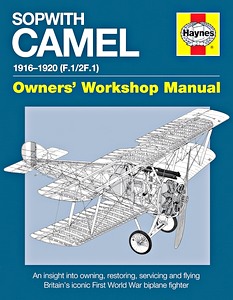Haynes Aircraft Manuals - unique technical aviation books
With over 200 million copies sold, the British publishing house Haynes is the world's largest publisher of maintenance and repair manuals. The Haynes Owners Workshop Manuals have been published since the 1950s. They describe in detail and well illustrated technical interventions on cars and motorcycles.
In the same style Haynes is also publishing "manuals" about airplanes and spacecraft. These books are not intended to actually carry out repairs, but they do give a unique impression of the technology of the machines in question.
An aircraft is always described from the views of the owner, the pilot and the aircraft technician. Beautiful color photos and technical drawings show the construction in detail.
The first volumes of this series were devoted to World War II combat aircraft (such as the Hurricane, Spitfire, Mustang and Me 109), but in the meantime books about more modern passenger planes, military aircraft, helicopters and spacecraft have been added.
These Haynes books are in English, but some titles have been translated into French (ETAI) and German (Motorbuch Verlag).
 Publisher: Haynes Publishing, Sparkford, Yeovil, Somerset (UK). For over 20 years the TMB Bookshop has been an official dealer for Haynes Manuals.
Publisher: Haynes Publishing, Sparkford, Yeovil, Somerset (UK). For over 20 years the TMB Bookshop has been an official dealer for Haynes Manuals.
Size: 27 x 21 cm (10.6 x 8.25 in)

Each Haynes Aircraft Manual shows the contruction in detail. These pages from the Haynes Concorde Manual show the landing gear.
What information does a Haynes Aircraft Manual provide?
A Haynes Aircraft Manual (in this example about the Supermarine Spitfire) generally contains the following chapters:
Introduction
THE SPITFIRE STORY
Introduction
The story of a fighting aircraft
The pattern of development
Squaring up to the enemy
The main production variants
RESTORE TO FLIGHT
Introduction
Anatomy of the Spitfire
- Fuselage
- Wings
- Undercarriage
- Hydraulic system
- Pneumatic system
- Brakes
- Flaps
- Engine cylinders, cylinderliners, cylinder block covers, valves, camshaft, camshaft auxiliary drives, pistons, crankcase, crankshaft, reduction gear, wheel case assembly, coolant pump, intercooler pump, fuel pump, electrical generator, supercharger, intercooler assembly, carburetion, ignition system)
- Fuel system
- Cooling system
- Oil system
- Intercooler
- Propeller
- Electrical sytem
- Flying controls
Weapons
Dimensions and weights
Obtaining spare parts
The limits to authenticity
Restoration and repair projects
THE OWNER'S VIEW
Introduction
First, catch your Spitfire
The question of provenance
The inevitable paperwork
Insurance
Running costs
THE PILOT'S VIEW
Introduction
Flying a Spitfire
- Start-up
- Pre-take-off checks
- Landing
Wartime pilots' views
Display flying a Spitfire
A boyhood dream fullfilled
THE ENGINEER'S VIEW
Introduction
Safety first!
Tools and working facilities
Jacking and airframe support
Recommended lubricants and fluids
Servicing a Spitfire
- Before Flight Servicing
- After Flight Servicing
- Primary Servicing
- Annual Servicing
- Minor Servicing
- Major Servicing
- Keeping records
Preserving a Spitfire
APPENDICES
Surviving Spitfires and Seafires
Airworthy Spitfires, worldwide
Glossary of terms
Useful contacts
Index

The historical section of the Haynes Aircraft Manuals describes the history, development and variants and is richly illustrated with several dozen archival photos.

Beautiful cross-sectional drawings give a good idea of the construction and the position of the components in the aircraft. This is a Vickers Wellington bomber.

Aircraft technology has the focus in every Haynes Aircraft Manual. From the wings and fuselage to the engine, landing gear and propeller, every component is depicted and described in detail. These books are entirely in colour.

The cockpit gets a lot of attention. Every gauge, button and lever is described. This is the instrument panel of an Avro Lancaster bomber.




